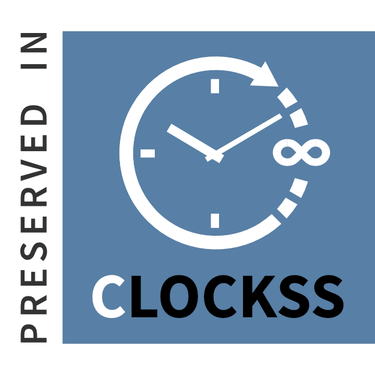Archivos
-

Las artes en la intersección. Hibridaciones y propuestas intermediales en el arte actual
Núm. 8 (2025)En las últimas décadas –y de manera especialmente significativa en el contexto de la cultura digital– las prácticas artísticas contemporáneas han intensificado los procesos de cruce, desplazamiento y desbordamiento de los límites disciplinares que tradicionalmente las estructuraban. Este número de Umática se sitúa en ese territorio de intersección, atendiendo a propuestas que sólo pueden comprenderse desde la hibridación formal, medial y material, y que ya no operan como variaciones periféricas de una disciplina, sino como prácticas constituidas desde el entre, el cruce y la inestabilidad de los lenguajes.
Los textos reunidos problematizan nociones como medio, obra, autoría, materialidad, percepción y experiencia estética, poniendo en cuestión los marcos categoriales heredados con los que históricamente se han pensado las artes. Uno de los ejes centrales del volumen es la reconsideración de los modos de percepción y atención que emergen en estas prácticas híbridas, que aparecen, por tanto, como espacios privilegiados para desestabilizar jerarquías sensoriales y epistémicas, y para ensayar modos alternativos de relación con lo visible, lo sonoro y lo legible y lo que ello propicia.
Este monográfico propone atender a la hibridación no sólo como una categoría formal, sino como un campo de fricción teórica, estética y política desde el que repensar las artes contemporáneas. Lejos de ofrecer taxonomías cerradas, el conjunto de contribuciones configura un espacio de reflexión abierto que invita a abordar la creación actual desde la complejidad, la intersección de saberes y el cuestionamiento constante de las fronteras disciplinares.
Editoras:
- Marina Hervás (Universidad de Granada, España)
- Rosa Benéitez Andrés (Universidad de Salamanca, España)
-

Remediaciones de la imagen: audiovisualización y (des)apropiaciones de la historia del arte y la cultura visual
Núm. 7 (2024)La aparición en 1972 de la serie de televisión Ways of Seeing, y del posterior libro homónimo, supuso una intervención radical en los relatos canónicos de la historia del arte que se convirtió rápidamente en un proyecto tan admirado como criticado. Más de cincuenta años después, Ways of Seeing sigue despertando interés por las irreverentes estrategias que implementó: remediación y montaje de imágenes, escrituras colaborativas, modos de (des)apropiación y otras formas no lineales de narrar la historia del arte desde experiencias situadas críticamente.
Si bien estas características posicionaron a Ways of Seeing como una referencia crucial en el ámbito anglosajón, en el contexto hispanoparlante esa influencia parece no haber tenido la misma amplitud. Para contribuir al debate en torno a la relevancia y vigencia de Ways of Seeing, el séptimo número de Umática integra un conjunto de reflexiones sobre distintas remediaciones de las imágenes, especialmente desde América Latina y España. Se trata de investigaciones a partir de ejercicios y experimentos que esquivan la arquitectónica conceptual e institucional de la autoría, la propiedad, la obra genial y la mirada masculina, entre otras características propias del canon de la historia del arte occidental.
Para abordar la remediación de las imágenes desde esta particular perspectiva, hemos situado el debate en torno a dos nociones fundamentales: la audiovisualización de la historia del arte y la (des)apropiación de la cultura visual. Como procesos complementarios, estas nociones operan transversalmente a lo largo de las distintas discusiones de este monográfico. A la estela de Ways of Seeing, se reúnen aquí trabajos que desbordan los acotamientos disciplinares y dan cabida a enfoques como la filosofía política de la imagen, posicionamientos desde los feminismos, reflexiones en torno a las ecologías audiovisuales, reconceptualización de archivos, iniciativas de pedagogías críticas y otras perspectivas teórico-metodológicas que, desde su hibridez, se aventuran en los distintos experimentos abiertos por los procesos de audiovisualización de la historia del arte y (des)apropiación de la cultura visual. No se trata de un homenaje ni de una revisión exhaustiva de Ways of Seeing, sino de sus posibles remediaciones, contradicciones y desajustes, a más de cincuenta años de su aparición y en latitudes que sobrepasan su marco de origen.
________________________
Editores:
Marilyn Payrol Morán (Benemérita Universidad Autónoma de Puebla)Alma Cardoso Martínez (Universidad Iberoamericana Puebla)
Renato Bermúdez Dini (Universidad Iberoamericana Ciudad de México)
________________________
Imagen de portada: TRES (ilana boltvinik + rodrigo viñas), Starlette incrustado en órbita, 2024, collage.
________________________
Con el apoyo de:
Proyecto de investigación Tensiones superficiales. Estudios críticos de la imagen y la representación, Universidad Iberoamericana Ciudad de México.Proyecto de investigación MCIN/AEI PÚBLICOS - Los públicos del arte y la cultura visual contemporáneas en España Nuevas formas de experiencia artística colectiva desde los años sesenta (Ref. PID2019-105800G) y grupo de investigación Devisiones. Discursos, genealogías y prácticas en la creación visual contemporánea, Universidad Autónoma de Madrid
-
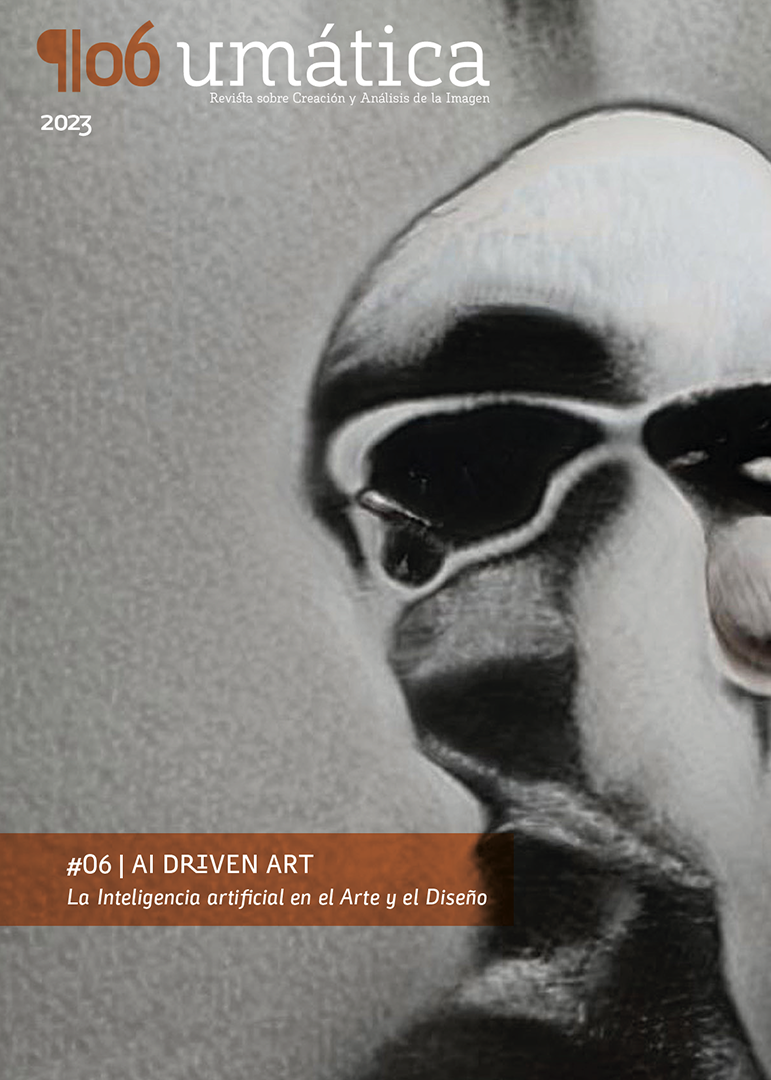
Art-Driven AI: la inteligencia artificial en el arte y el diseño
Núm. 6 (2023)Explorando la Intersección entre Arte e IA: Un Enfoque Reflexivo
El sexto número de Umática se sumerge en la intersección entre el arte y la inteligencia artificial (IA) inspirado por la obra innovadora de Joanna Zylinska en "AI Art, Machine Visions and Warped Dreams" (2020). La reflexión que se desprende de este trabajo propone una visión matizada que invita a considerar la coexistencia creativa entre humanos y tecnología. Los contenidos abarcan diversas perspectivas relacionadas con la actual problemática que implican estos sistemas digitales en el ámbito de la creación artística en particular, desde la creación de contenido artístico con medios digitales de IA a la reflexión sobre los principios éticos en la generación de imágenes a través de un prompt en lo que el profesor Juan Martín Prada define como “creatividad parasitaria”. En esta edición, se presentan entrevistas exclusivas con ambos autores, profundizando en sus perspectivas y contribuciones al diálogo sobre arte e inteligencia artificial.
Se exploran las implicaciones filosóficas del predominio de los simulacros en la era de la IA, planteando cuestiones sobre la percepción de la realidad y la verdad en un mundo mediado por la red. Destacamos la necesidad de abordar la transformación de la autoría, originalidad y ética en la creación artística, junto con la importancia de la formación en nuevos modelos generativos y la crítica de la IA en el arte contemporáneo. Con esto se señala la importancia de la educación, la transparencia y accesibilidad equitativa a la IA para mitigar desigualdades y desinformación.
Los medios digitales de IA permiten explorar la Memoria Visual Colectiva y Relaboración Histórica. Podemos reflexionar sobre el impacto de la IA en la comprensión del pasado, sugiriendo nuevas formas de rememoración a través de imágenes generadas por IA y las posibles falsificaciones o remezclas que pueden desarrollarse en los relatos históricos. La democratización de la IA amplía las posibilidades creativas, pero también plantea retos éticos a la hora de combinar diferentes estilos y elementos en sistemas generativos. Este número pone de manifiesto algunas de las necesidades que debemos abordar en los próximos años, dada la velocidad a la que cambian las tecnologías digitales.
Imagen portada:
ZYLINSKA, J. (2023) -Still from A Gift of the World (Oedipus on the Jetty), [Photofilm, 9’25’’, 2021]. |© Zylinska, 2023 (Cortesía de la Autora)[1]
--------------------
[1] Fragmento de un fotograma del proyecto homónimo de 2021 en el que Zylinska revisa la conocida película fotográfica apocalíptica de Chris Marker, La Jetée (1962), entrenando un modelo StyleGAN2 con imágenes fijas extraídas del original de Marker mientras se escribe un guión con la ayuda de un modelo lingüístico de IA.
-

Arte, Arquitectura y Cultura visual
Núm. 5 (2022)Al pensar la ciudad convergen diversas esferas de conocimiento que abren un abanico de aproximaciones para la comprensión de esta; un lugar desbordado de la experiencia, un territorio en expansión marcado actualmente por el fenómeno de la globalización y la aceleración de la experiencia en todas sus dimensiones. En este sentido, no hemos podido inhibirnos de reflexiones procedentes de la teoría del arte, así como de determinadas consideraciones filosóficas, sociológicas, psicológicas, científicas, históricas, antropológicas y, en definitiva, vitales al ser éstas parte consustancial de la pasión que impulsa una cultura visual que pretende hacer visibles los dispositivos y retóricas de legitimación que actúan sobre la urbe como códigos formalizados, y en consecuencia sobre los modos de relación social.
Este número monográfico Umática. Arte, Arquitectura y Cultura visual ha tratado de agrupar visiones contemporáneas como acto de resistencia cultural. La interacción entre disciplinas despliega hoy en día un espació abierto y hemos puesto atención sobre algunos desarrollos arquitectónicos y prácticas artísticas en los que hallamos vectores de significación para indagar en las fisuras que detectamos entre la función y el uso de la arquitectura y el urbanismo, entre la memoria y el presente del hecho arquitectónico como artefacto cultural significante que es. El análisis de la realidad circundante y de sus causas, y la reflexión continuada en torno a la experiencia cotidiana -desde una perspectiva artística que practica más la mirada del paseante activo/crítico que la del turista consumidor/usuario- da cuerpo a esta recopilación; proyectos que interrogan, cuestionan, definen, subrayan, predicen o ponen en alerta, si no directamente de modo tangencial, sobre el derecho a la ciudad que Henry Lefebvre teorizó. (...)
Imagen cubierta: Luis Camnitzer, El crimen perfecto (2018) | © Luis Camnitzer, 2018 (Cortesía del Autor).
-
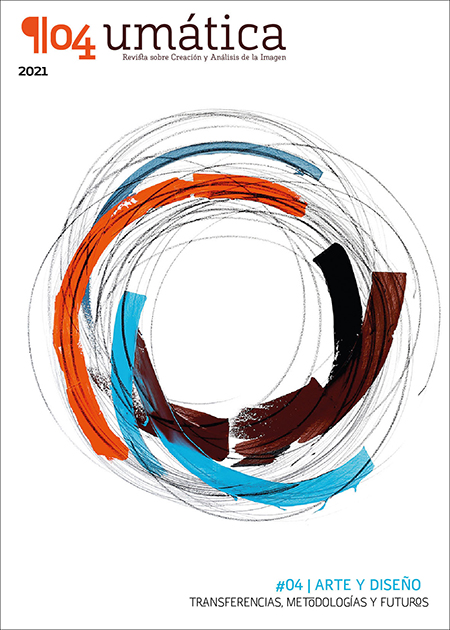
Arte y diseño: transferencias, metodologías y futuros
Núm. 4 (2021)En el actual mundo de expansión transversal, donde la cultura ejerce de tensión sobre los distintos ámbitos de conocimiento, se hace más necesario que nunca una perspectiva expandida que permita la interacción entre disciplinas como ofrecen los procesos de diseño. El diseño ofrece un campo de exploración donde la experimentación, la creación y lo tangible se conectan en unos presentes que auguran lo futurible. Este monográfico Umática ha tratado de hacer una aproximación a esos otros presentes.
Hay cuestiones tradicionales del ámbito del diseño que se van desplazando del centro de los debates, como puede ser el dogma de la búsqueda de soluciones (nuevas soluciones a viejos problemas) cuando emerge la necesidad real de formular nuevas preguntas. Todo se pone en cuestión, porque todo se re-diseña, se re-dimensiona, se re-cicla, se re-hace, se re-toma, se ´RE-´… Desde la visión de lo cotidiano, de lo más humano, de lo social, etc., sin grandes ambiciones corporativistas, dando respuesta a lo que tendremos que vivir y como serán los escenarios y los objetos que nos acompañarán en nuestras vidas.
Dar respuestas de diseño con una reconfiguración respecto a las problemáticas desde el punto de vista de lo futurible y respecto a las dialécticas del diseño con otros ámbitos disciplinares. Es momento de revisar los modelos y metodologías de ideación y creación que ya se aplican y que, probablemente, no son visibles en los resultados mismos de los procesos de diseño.
Imagen de cubierta. Pepe Gimeno. Buscando desde lo inexacto el circulo perfecto, 2017 (Acrílico sobre lienzo). Cortesía de Pepe Gimeno. Premio Nacional de Diseño 2020. pepegimeno.com
-
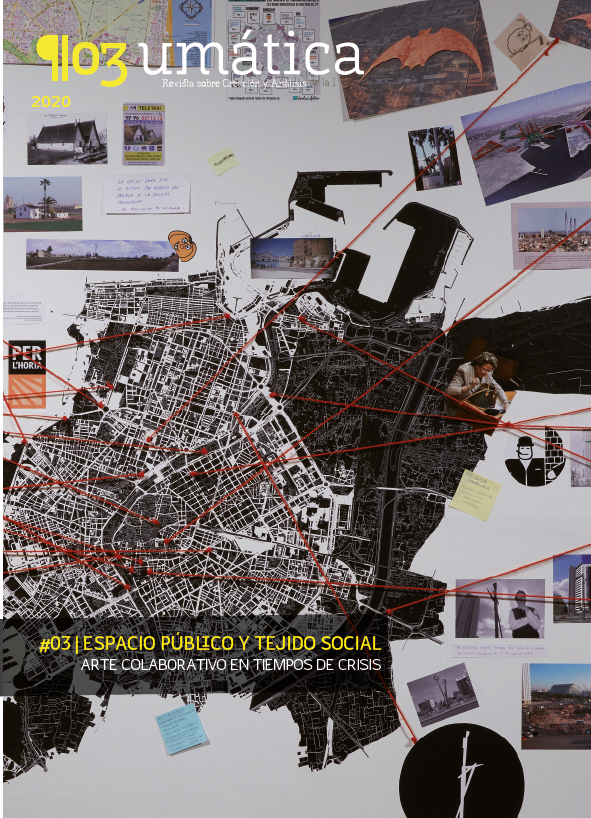
Espacio público y tejido social: arte colaborativo en tiempos de crisis
Núm. 3 (2020)Bajo el título “Espacio público y tejido social: arte colaborativo en tiempos de crisis”, el equipo editorial de “Umática, Revista sobre creación y análisis de la imagen”y el proyecto de Investigación “El barrio como escenario de pedagogías críticas y arte colaborativo”(PGC2018-094351-B-C42), del Ministerio de Economía y Competitividad, presentan un conjunto de aportaciones críticas que revisan las claves teóricas, metodológicas y prácticas asociadas al empuje que desde el impacto de la crisis de 2008 han recibido aquellas políticas participativas o colaborativas en la gestión y en la creación artística vinculadas al barrio como contexto específico. La aportación de la portada del número por parte de Rogelio López-Cuenca supone, más allá del honor con el que los responsables de esta edición la reciben, toda una declaración de intenciones sobre el horizonte al que aspiran las revisiones mencionadas. La imagen se corresponde con la instalación Mapa de Valencia (2015) [1]. Una instalación que documenta el trabajo del colectivo implicado en el taller No/W/Here, coordinado por López-Cuenca y con la colaboración del IVAM y de la UPV[2], da cuenta de un cambio de paradigma en el que el impacto de la intervención artística se vislumbra en aquellos lugares que nuestro entorno capitalizado deja al descubierto.
Con un amplio recorrido durante las últimas décadas, los esquemas de trabajo colectivo que han definido estas apuestas de intervención perfilan hoy más que nunca, en plena crisis sanitaria y económica producida por el COVID-19, nuestras posibilidades de respuesta artística o cultural.
Especialmente tras el impacto de la crisis de 2008, desde distintos lugares surgieron demandas de replanteamiento de la relación entre el arte que se produce y las audiencias a las que se dirige, desde modelos de gestión cultural a esquemas de prácticas artísticas preocupadas por el entorno que las acoge. Desde entonces el debate se ha enfocado en la relación contextual de la cultura o del arte desde una perspectiva social, dejando a un lado la atención exclusiva que el binomio cultura-economía recibía en modelos de gestión previos. Pese a que dicho replanteamiento se ha aplicado en muchas ocasiones, antes que como un plan programado y puesto en práctica de forma paulatina, como una forma de respuesta necesaria ante la propia escasez de medios producida por contextos de crisis, su presencia continuada a lo largo de este tiempo y las fricciones producidas en su relación con modelos de gestión y creación tradicionales parecen indicar un cambio de paradigma consolidado como demuestran las distintas aportaciones que aquí se presentan.
La crisis de 2008 evidenció la incapacidad de muchos museos y centros de arte para repensarse, pero a su vez, con el empuje de las urgentes demandas de transparencia de una ciudadanía indignada, llevó a algunos de ellos a iniciar un proceso inédito de captación de nuevos públicos y visibilización de sus actividades. La situación permitió además que su mirada se dirigiera hacia el barrio que los acogía, con gente que no sólo entraba físicamente en la institución sino que mantenía una participación e intercomunicación activas. Así, los modelos de práctica artística colaborativa que ya habían sido puestos en marcha, junto a una sociedad cada vez más consciente de que el arte y la cultura les pertenecía, convirtieron la producción artística en un asunto colectivo que implicaba a la pedagogía como un aliado necesario.
A día de hoy podemos afirmar que, bajo el ideal de las pedagogías críticas o radicales, el arte aparece más que nunca como un proceso de aprendizaje y negociación colectivo y responsable, cuyo horizonte antes que en el desarrollo individual de la persona se sitúa en el cambio social propiamente dicho.
La crisis sanitaria del COVID19, y sus implicaciones domésticas, sociales y económicas generan, si cabe, un reto mayor: repensar nuestras actuaciones sin salir de casa, plantearlas para escenarios virtuales, o planificarlas para pequeños grupos de población en un momento en el que el arte y la cultura ha puesto en evidencia su necesidad y que sus fórmulas de producción, consumo e interacción, pueden ser una tabla de salvación o un alivio para los momentos difíciles que hemos vivido y para los que sin duda vendrían. (Seguir leyendo)
Editores: Isabel Tejeda Martín (Universidad de Murcia) & Ignacio López Moreno (Universidad de Granada)
Imagen Portada: Rogelio López C., Mapa de Valencia (2015). Fotografía de la Instalación/versión de 2019 en el MNCARS (Madrid). | © Rogelio López Cuenca.
[1]Rogelio López C., Mapa de Valencia (2015). Fotografía de la Instalación/versión de 2019 en el MNCARS (Madrid). | © Rogelio López Cuenca.
[2]Colaboran en el proyecto el equipo del taller No/W/Here Valencia (IVAM y Facultad de BBAA de la UPV, Valencia 2015): Judith Álvarez García, María Aucejo, Silvia García, Luis Lisbona, Neus Lozano-Sanfélix, Raúl Ortega Moral, Mª Jesús Parada, Raquel Planas, Maritxel Quevedo, Chiara Sgaramella, Natividad Soriano, Vanesa Valero y María Vidagany-Murgí. | Edición vídeo: Elo Vega.
-
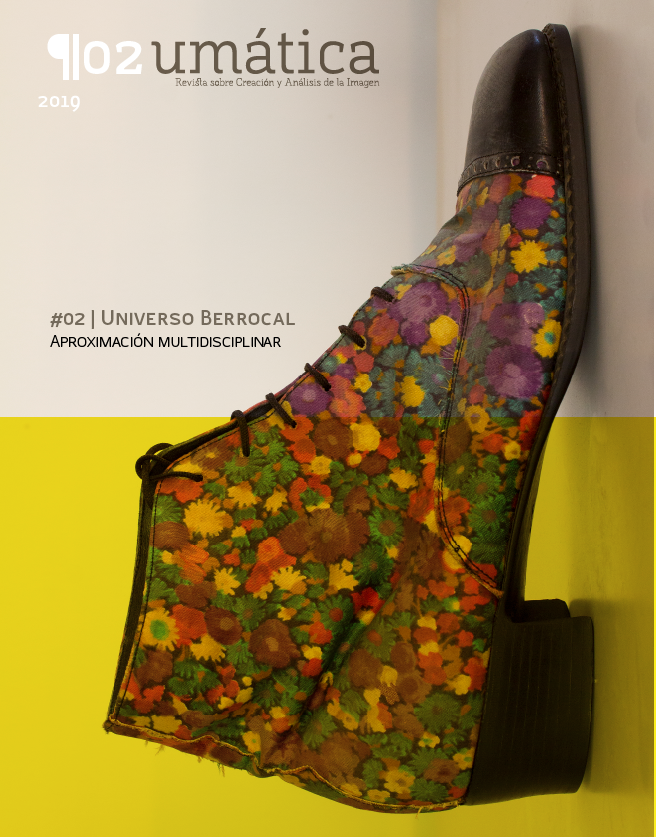
UNIVERSO BERROCAL. Aproximación multidisciplinar al proceso creativo del escultor Miguel Berrocal
Núm. 2 (2019)El equipo editorial de Umática –Revista para el análisis de la imagen y la creación– y la Fundación Escultor Berrocal Para las Artes presentan un volumen dedicado a uno de los escultores españoles más singulares y fascinantes del siglo XX: Miguel Berrocal (1933-2006). Artista de reconocido prestigio cuyas obras se encuentran en numerosos museos y las principales colecciones públicas y privadas del mundo. La obra y los procesos de Berrocal permiten reflexionar sobre la profunda interrelación entre arte, ciencia, diseño y tecnología. [ver editorial]
-
![nº1 [Umática_ Revista sobre creación y análisis de la imagen] Dolly y los otros Prometeos: Imágenes y retos del s.xxi.](https://www.revistas.uma.es/public/journals/32/cover_issue_445_es_ES.png)
Dolly y los otros Prometeos: Imágenes y retos del s.xxi.
Núm. 1 (2018)En 1968, Philip K. Dick nos invitaba a pensar sobre la posibilidad de que los androides pudieran soñar con ovejas eléctricas, abriendo bajo nuestros pies un abismo inquietante (y aludiendo a la formulación de M. Mori[1]en su célebre ensayo de 1970) que nos atenaza desde la posibilidad de alimentar y dar nueva vida al clásico mito de Prometeo. Tres décadas después, el 22 de febrero 1997 Ian Willmut y Keith Cambell del Instituto Roslin nos descubrieron que de ser así, esas ovejas artificiales no tendrían por qué ser ni mecánicas ni eléctricas; podían ser de una raza doméstica como la Finn Dorsten, i.e. todas podían ser clones como Dolly.
“Dolly y los otros Prometeos: imágenes y retos del s.xxi” es el título con el que, el equipo editorial de la revista Umática, aspira a inaugurar este nuevo espacio para la discusión académica y la difusión de resultados de investigación relacionadas con ámbitos de la creación, el arte y la cultura visual.
Se trata de un título discutible y, por ello, lo suficientemente polémico como para suscitar un debate sobre las diferentes implicaciones teóricas, éticas y sociales de las transformaciones tecnológicas como un factor sistémico de desestabilización categorial. Entre otras implicaciones, se desencadena la necesidad de una reconceptualización constante de nociones básicas que, por obvias, parecen no tener que ser redefinidas –como por ejemplo, la noción misma de imagen– revelando el carácter artificial de una construcción de la realidad que de forma imprevista e imprevisible nos transforma como sujetos. De forma un tanto alarmante se dice, por ejemplo, que las aludidas transformaciones tecnológicas provocan una “desocialización” de las relaciones interpersonales que va ligada a la vertiginosa espectacularización del individuo en los sistemas y dispositivos inteligentes, y que además re-introducen nuevas formas de dominio y construcción tecnológica –social e imaginaria– de todos nosotros en esta civilización de la imagen.
El objetivo principal de este primer número ha sido recoger una serie de aportaciones realizadas por investigadores/as y creadores/as en los distintos formatos arbitrados que la revista ofrece (i.e. artículos de investigación o revisión, proyectos de creación o ensayos visuales) cuyo enfoque y desarrollo sirva para alimentar un debate crítico sobre la interconexión disciplinar entre ciencia, arte y tecnología.
Este primer número acoge, por tanto, trabajos relativos al amplio espectro de los retos [tecnológicos, éticos, sociológicos, conceptuales, etc.] planteados —en el día de hoy, y, previsiblemente, en el día de mañana— por el diverso espectro de los desarrollos de la producción y los usos de las imágenes: desde imágenes usadas para hacer los planos de las cámaras subterráneas de una pirámide, para orientarse en el metro de Moscú o para ilustrar un trabajo acerca de la fotosíntesis, a imágenes generadas de forma autónoma por un dispositivo interactivo o la tan cotidiana producción y difusión masiva de auto-fotos (Selfie). Desde las RealDolls, los robots diseñados por la empresa Boston Dynamics (comprada hace cuatro años por Google), etc., a los cuadros de Juan Francisco Casas o las obras de Ron Mueck, por ubicarnos ahora en el campo del Arte. Desde cierto punto de vista, tales transformaciones nos enfrentan también a los retos derivados del impacto de los nuevos desarrollos de la Teoría de las Imágenes sobre las disciplinas académicas que tradicionalmente han acaparado el estudio del devenir de las imágenes — i.e. la Historia del Arte, la “Semiótica de las imágenes”, etc.
Umática se rotula a sí misma como un espacio?de?investigación?“sobre?análisis?y creación de la imagen” y,??por ello, uno de nuestros propósitos generales –y también de este número en particular– es explorar vías capaces de relativizar el enfoque semiótico de las imágenes para comprender los fenómenos que configuran nuestra cultura visual. (Continúa leyendo)
[1].?Mori, Masahiro (1970). Bukimi no tani (?????) The uncanny valley. Energy, 7 (4), 33–35.


23.png)

